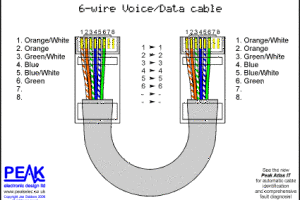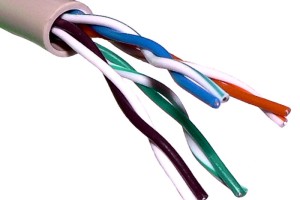Network cabling falls into six subsystems:
Demarcation point is the point where the telephone company network ends and connects with the on-premises wiring at the customer premises.
Equipment or Telecommunications Rooms house equipment and wiring consolidation points that serve the users inside the building or campus.
Vertical or Riser Cabling connects between the equipment/telecommunications rooms, so named because the rooms are typically on different floors.
Horizontal wiring can be IW (inside wiring) or Plenum Cabling and connects telecommunications rooms to individual outlets or work areas on the floor, usually through the wireways, conduits or ceiling spaces of each floor.
Work-Area Components connect end-user equipment to outlets of the horizontal cabling system.
Network cabling design and installation is governed by a set of standards that specify wiring data centers, offices, and apartment buildings for data or voice communications using various kinds of cable, most commonly category 5e (CAT-5e), category 6 (CAT-6), and fibre optic cabling and modular connectors. These standards define how to lay the cabling in various topologies in order to meet the needs of the customer, typically using a central patch panel (which is normally 19 inch rack-mounted), from where each modular connection can be used as needed. Each outlet is then patched into a network switch (normally also rack-mounted) for network use or into an IP or PBX (private branch exchange) telephone system patch panel.
Lines patched as data ports into a network switch require simple straight-through patch cables at each end to connect a computer. Voice patches to PBXs in most countries require an adapter at the remote end to translate the configuration on 8P8C modular connectors into the local standard telephone wall socket. No adapter is needed in the U.S. as the 6P2C and 6P4C plugs most commomly used with RJ11 and RJ14 telephone connections are physically and electrically compatible with the larger 8P8C socket. RJ25 and RJ61 connections are physically but not electrically compatible, and cannot be used. In the UK, an adapter must be present at the remote end as the 6-pin BT socket is physically incompatible with 8P8C.
It is common to color code patch panel cables to identify the type of connection, though structured cabling standards do not require it except in the demarcation wall field.
Cabling standards demand that all eight conductors in Cat5/5e/6 cable are connected, resisting the temptation to ‘double-up’ or use one cable for both voice and data. IP phone systems, however, can run the telephone and the computer on the same single cable.
[hozbreak]
Structured Cabling Standards
Network cabling standards are used internationally and are published by ISO/IEC, CENELEC and the Telecommunications Industry Association (TIA). Building Industry Consulting Service International is a recognised independent trainer of structured cabling installers with manufacturer independent design and installation best practice documents, it also plays a major role along with industry leaders in developing and designing the US standards.
– ANSI/TIA-568-C.1, Commercial Building Telecommunications Cabling Standard, 2009
– ANSI/TIA-568-C.2, Balanced Twisted-Pair Telecommunication Cabling and Components Standard, published 2009
– ANSI/TIA-568-C.3, Optical Fiber Cabling Components Standard, published 2008, plus errata issued in October, 2008.
– TIA-569-B (2004; Amd 1 2009) Commercial Building Standard for Telecommunications Pathways and Spaces
– ANSI/TIA/EIA-606-A-2002, Administration Standard for Commercial Telecommunications Infrastructure.
Some European countries use these although CENELEC or ISO standards are more relevant in European countries, the main CENELEC document being EN50173, which introduces contextual links to the full suite of CENELEC documents. ISO11801 heads the ISO documentation.



